Growing Thyme in a Greenhouse: Secrets to a Fragrant Harvest All Year Round
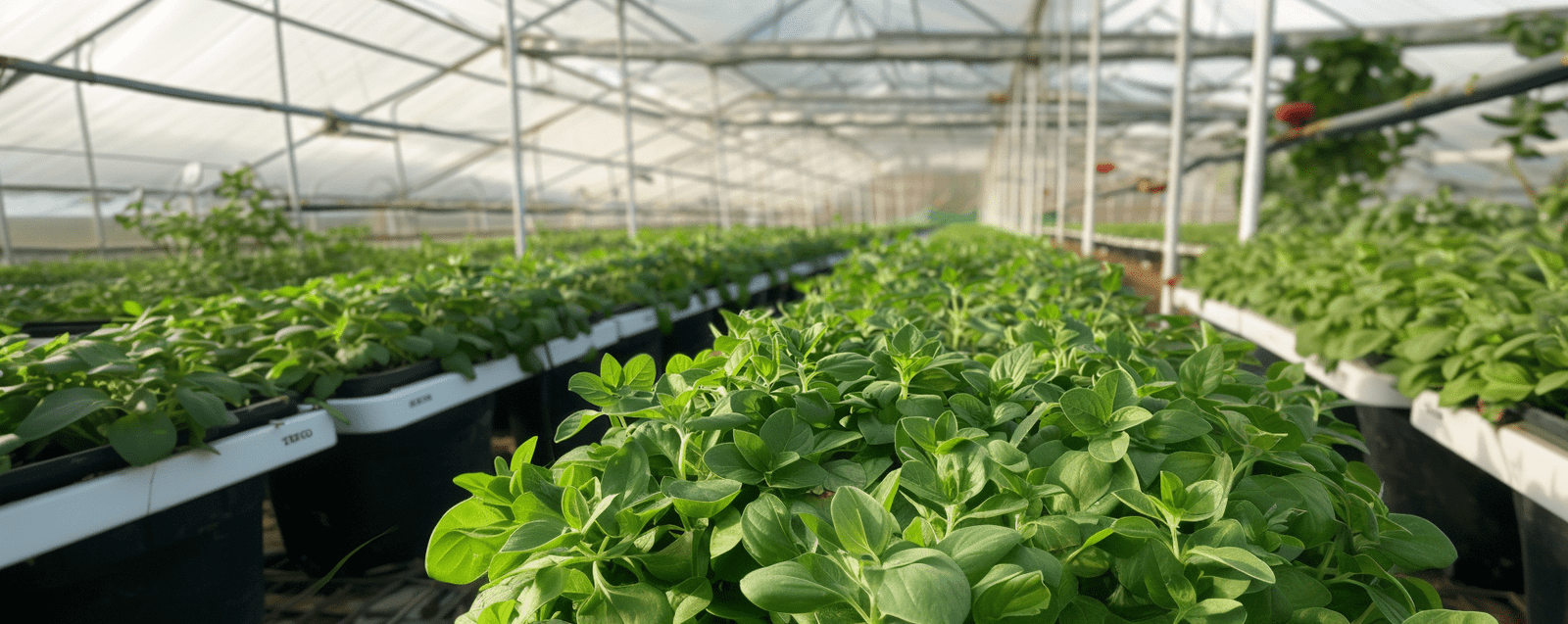
Imagine: a snowstorm is howling outside the window or autumn rain is pouring down, and you enter your greenhouse, and you're enveloped in the warm, spicy, slightly bitter aroma of thyme. Do you dream of always having fresh sprigs of this amazing plant on hand for culinary experiments, aromatic tea, or homemade medicinal infusions, but the vagaries of the weather and short summers in your region put that dream in doubt? Perhaps you've already tried growing thyme on a windowsill, but it didn't produce a lush, fragrant plant? A greenhouse can be your reliable ally in conquering this Mediterranean plant, allowing you not only to protect it from harm but also to unlock its full potential. Let's embark on a journey through the world of greenhouse thyme cultivation and learn how to transform a humble bush into a source of inexhaustible aroma and benefits.
Benefits of growing thyme in a greenhouse
Growing thyme in protected soil conditions provides the gardener with a number of significant advantages:
- Year-round harvest or significant extension of the season: In a heated greenhouse, you can harvest fresh thyme almost constantly. In an unheated greenhouse, the harvesting period can be significantly extended compared to open ground.
- Protection from adverse weather conditions: A greenhouse will protect delicate plants from severe frosts (especially important for less winter-hardy varieties), frosts, excessive rainfall, hail, and cold winds.
- Accelerated plant development: In controlled greenhouse conditions, thyme grows faster, especially in the early stages.
- Improving the quality of greens: With proper care, greenhouse thyme can have a richer aroma and better marketability.
- Optimal control over growing conditions: The ability to regulate temperature, soil and air humidity, as well as lighting.
- Simplifying reproduction: In a greenhouse, it is easier to create conditions for rooting cuttings or growing seedlings from seeds.
- Reducing the risk of damage by certain diseases and pests: An isolated space helps limit their spread, although it requires attention to prevention.
- Possibility of growing more heat-loving and rare varieties: A greenhouse allows you to experiment with varieties that don't do well in your region's climate.
Choosing a Thyme Variety for a Greenhouse
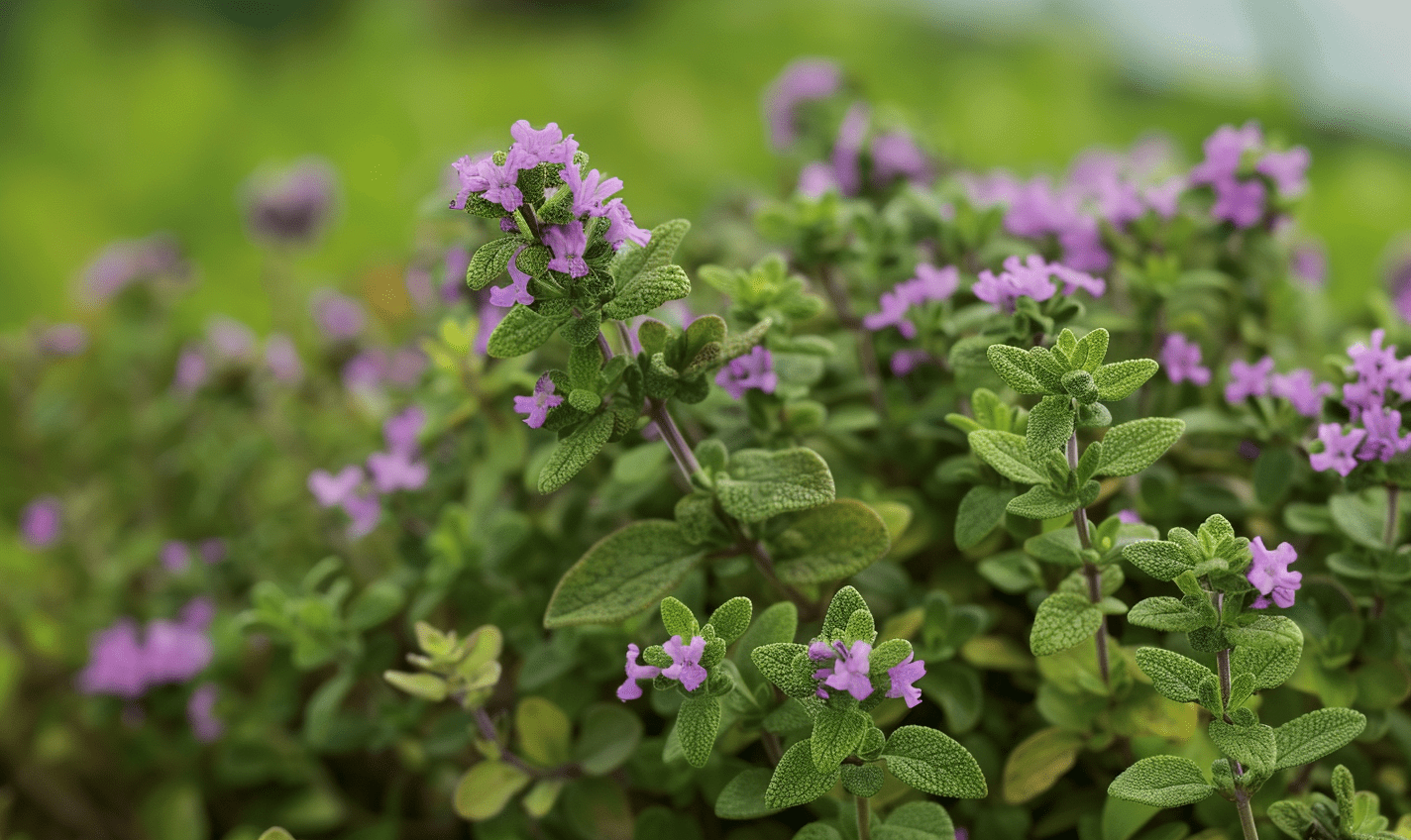
There are a huge variety of thyme species and cultivars (Thymus), varying in height, leaf shape and color, flower color, and, of course, aroma nuances. Many are suitable for greenhouse use, but the choice depends on your goals.
- Common thyme (Thymus vulgaris): The most common type, the classic "pharmacy" and culinary thyme. It has a strong, spicy aroma. There are many varieties:
- German Winter: Relatively winter-hardy, with a strong aroma.
- 'French Summer': A more delicate aroma, considered a culinary standard.
- 'Silver Queen': An ornamental variety with white-edged leaves.
- Lemon Thyme (Thymus citriodorus): It has a distinct lemon aroma. It's perfect for tea, desserts, and fish dishes. Varieties:
- 'Golden Lemon': Leaves with yellow spots.
- 'Archer's Gold': Bright yellow leaves.
- Creeping Thyme (Thymus serpyllum): A low-growing, groundcover species that forms dense mats. It is often used for ornamental purposes, but also has a pleasant fragrance. Numerous cultivars with different flower colors (pink, purple, white) are available.
- Early thyme (Thymus praecox): It is also a ground cover, forming dense cushions.
What to look for when choosing a variety for a greenhouse:
- Purpose: For culinary and medicinal purposes, it's best to choose varieties of common thyme or lemon-scented thyme with a strong aroma. Groundcover varieties are also suitable for decorative purposes in containers.
- Growth rate and habit: Compact varieties are more suitable for limited space.
- Disease resistance: Although conditions in the greenhouse are controlled, the stability of the variety is always a plus.
Where to buy planting material?
- Seeds: An affordable option, but thyme seeds are small and do not always germinate evenly.
- Seedlings/saplings: You can buy ready-made potted plants at garden centers or from private collectors. This will speed up the harvest.
- Cuttings: If you or someone you know already has thyme, it can be easily propagated by cuttings.
Preparing the greenhouse and soil
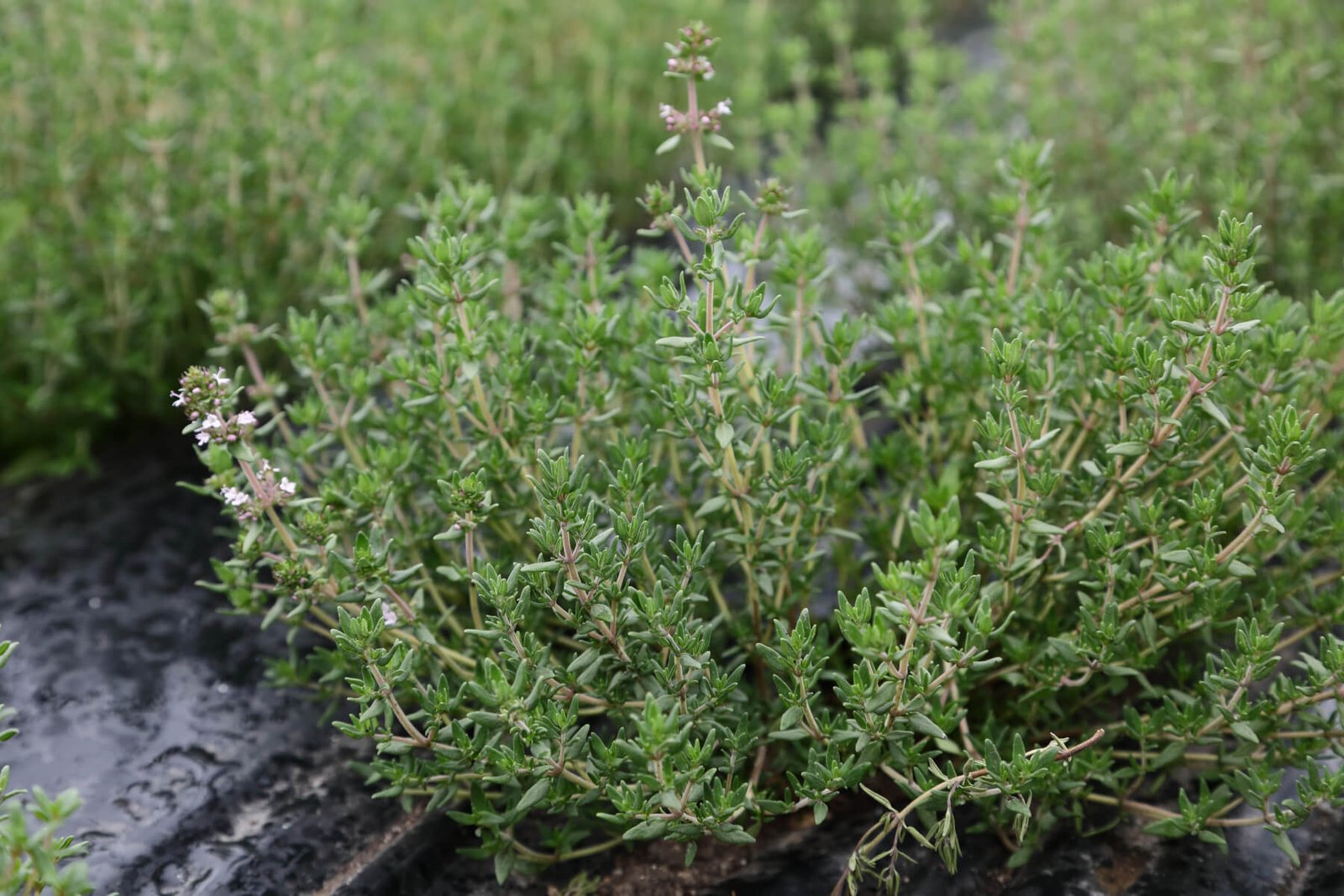
When to start preparing?
2-3 weeks before the planned planting or sowing.
Soil requirements for thyme:
Thyme is a drought-resistant plant, preferring light, well-drained, loose soils with a neutral or slightly alkaline pH. It absolutely does not tolerate stagnant water or heavy, acidic soils.
- Soil type: Sandy loam, sandy, stony or light loamy soils are ideal.
- Acidity (pH): 6.0-8.0. If the soil is acidic, liming is necessary (dolomite flour, lime, wood ash).
- Drainage: Critically important! Ensure good drainage of excess water.
Stages of soil preparation in a greenhouse (when planting in the ground):
- Cleaning the greenhouse: Remove all weeds and plant debris from previous crops. Disinfect the greenhouse structures.
- Digging the soil: Digging depth: 15-20 cm.
- Improving structure and drainage:
- If the soil is heavy, add coarse sand, fine gravel, agroperlite or vermiculite (up to 1/3 of the soil volume).
- Add a small amount of well-rotted compost (1-2 kg/m²). Thyme doesn't require very fertile soil; too much organic matter can cause the plants to stretch and reduce their aroma.
- Liming (if necessary): Apply lime or dolomite flour a few weeks before planting if the soil is acidic.
- Formation of beds: It is recommended to make raised beds (15-20 cm high) to improve drainage.
Preparing containers (for container growing):
- Choose shallow but wide pots or containers with large drainage holes. Thyme has a shallow root system.
- Place a thick layer of drainage material (expanded clay, broken brick, gravel) on the bottom – at least 1/4 of the height of the pot.
- Prepare the substrate: mix a general-purpose soil for cacti and succulents or prepare a mixture of garden soil, sand, and a small amount of compost (2:2:1). The substrate should be very loose.
Optimal greenhouse conditions for thyme:
- Temperature:
- Optimal for growth: +20-28°C.
- Thyme is quite cold-resistant, but in a greenhouse it is better to avoid sudden changes.
- In an unheated greenhouse, many varieties can survive the winter at temperatures down to -15°C (sometimes even lower) under snow cover or light cover if the soil is dry. However, to ensure winter survival and early spring growth, it's best to maintain a minimum above-zero temperature (2-5°C).
- Lighting: Thyme is extremely photophilous. It requires maximum sunlight (at least 6-8 hours of direct sun per day). In a greenhouse, place it in the sunniest spots. If light levels are insufficient during the fall and winter, supplemental lighting with phytolamps is recommended.
- Ventilation: Thyme dislikes stagnant, humid air. Regular and effective ventilation of the greenhouse is essential.
Planting thyme in a greenhouse
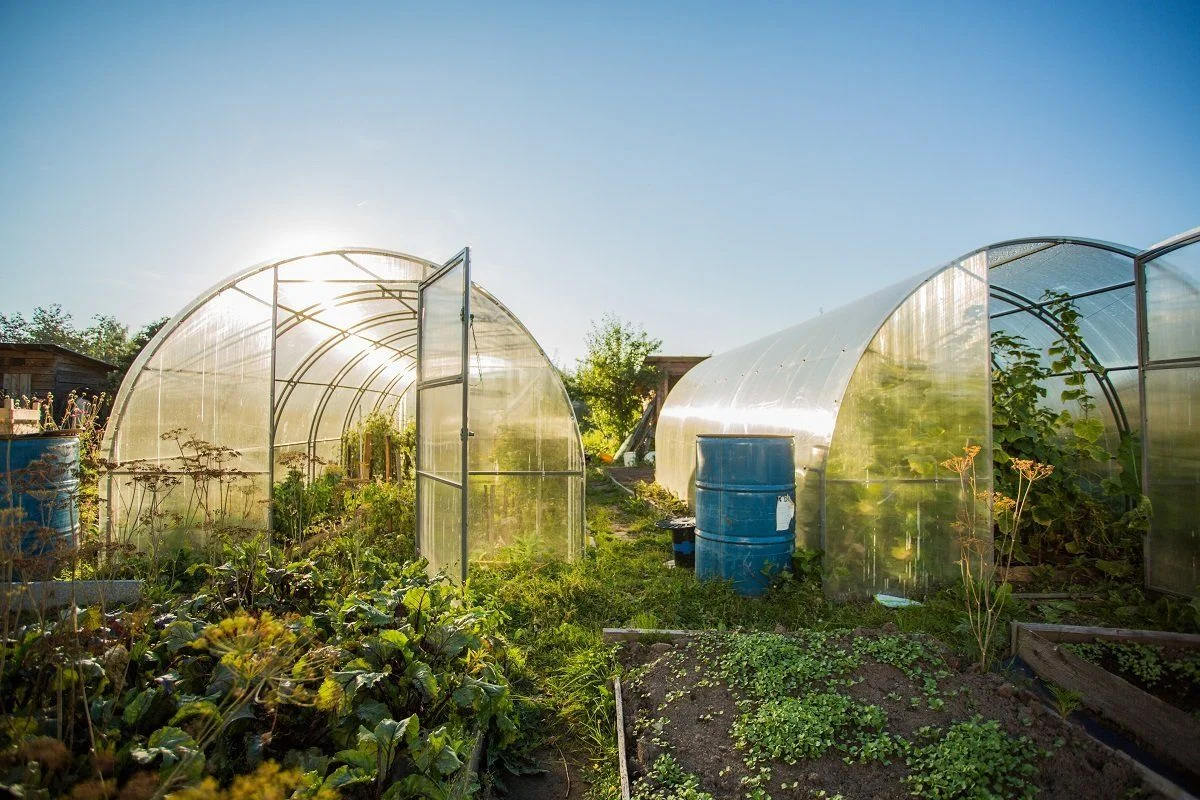
Thyme can be grown from seeds, cuttings, division of the bush, or by planting ready-made seedlings.
- Growing from seeds:
- Sowing time: For seedlings – February-March. In the greenhouse soil (if it has warmed up) – April-May.
- Seed preparation: Thyme seeds are very small. For convenience, they can be mixed with sand. Special pre-sowing treatment is usually not required.
- Sowing for seedlings:
- Fill the bowls or cassettes with loose, moist substrate.
- Spread the seeds evenly over the surface, without burying them or just lightly sprinkling them with a thin layer of sand or vermiculite (0.2-0.3 cm).
- Spray with a spray bottle and cover with film or glass.
- Germinate at 18-22°C in the light. Seedlings will appear in 10-20 days.
- Ventilate and humidify regularly.
- Pricking out: When the seedlings have 2-3 pairs of true leaves, they are pricked out into separate pots or thinned out.
- Landing at a permanent location: The seedlings are planted in the greenhouse when they reach a height of 5-7 cm and the threat of severe cold weather has passed (for unheated greenhouses).
- Cuttings:
The easiest and fastest way of reproduction.
- Timing of cuttings: Spring (before flowering) or summer (after flowering).
- Cuttings: Cut off apical or lateral green or semi-woody shoots 5-8 cm long. Remove the lower leaves by 1/3-1/2 the length of the cutting.
- Rooting:
- In water: Place the cuttings in a glass with a small amount of water. Roots will appear in 2-4 weeks.
- In the substrate: Plant the cuttings in a loose, moist substrate (a mixture of peat and sand, perlite, or vermiculite) to a depth of 1.5-2 cm. Cover with plastic wrap or a transparent container. Root at a temperature of 18-20°C, regularly ventilating and moistening.
- Planting rooted cuttings: After a good root system has formed (after 3-5 weeks), plant it in a permanent location.
- Dividing the bush:
Suitable for mature, overgrown plants (3-5 years).
- Deadlines: Early spring or autumn.
- Technique: Carefully dig up the bush. Using a sharp knife or shovel, divide it into several sections, ensuring each section has sufficient roots and several shoots. Sprinkle the cut sections with crushed charcoal. Immediately replant the sections in their new location.
- Planting seedlings (purchased or grown):
- Planting times: Spring or fall. In a heated greenhouse – almost any time.
- Planting technique:
- Prepare holes or furrows.
- Carefully remove the seedling from the pot.
- Place in the hole so that the root collar is at soil level.
- Cover with soil, compact lightly and water.
- Planting scheme:
- Between plants: 15-25 cm (depending on variety).
- Between rows: 25-30 cm.
Caring for thyme in a greenhouse

- Watering:
- Thyme is drought-resistant. The main rule is not to overwater!
- Water moderately, only after the top layer of soil has completely dried out to a depth of 2-3 cm.
- Watering frequency depends on greenhouse conditions. More frequently in summer, and very rarely or not at all in winter (especially in a cool greenhouse) if the soil remains slightly moist.
- Use settled water at room temperature. Water at the roots.
- Air humidity:
- Thyme prefers dry air. Misting is usually unnecessary and can even be harmful, promoting the development of fungal diseases.
- Provide good ventilation.
- Fertilizer (top dressing):
- Thyme doesn't require a lot of fertilizer. Excess nutrients reduce the intensity of its aroma and winter hardiness.
- If the soil has been well prepared, you can do without fertilizing or apply one fertilizing in early spring with a very weak solution of complex mineral fertilizer or an infusion of wood ash.
- Pruning and shaping:
- Regular pruning stimulates tillering, rejuvenates the plant and helps maintain a compact shape.
- In spring: Carry out sanitary pruning, removing dry and damaged branches.
- After flowering (or throughout the summer): Shorten shoots by 1/3 or to the woody part to stimulate new growth and prevent stretching. Do not prune too low; leave only the old wood.
- Cutting greens for edible use is also part of care and training.
- Loosening and weeding:
- Gently loosen the soil around the plants to improve aeration, especially after watering.
- Remove weeds in a timely manner.
- Mulching with a thin layer of fine gravel or sand will help keep the soil loose, prevent weed growth, and protect the root collar from excess moisture.
- Preparing for winter (for unheated or poorly heated greenhouses):
- In autumn, stop fertilizing and reduce watering to a minimum.
- Before the onset of severe frost, you can lightly cover plants with dry leaves, spruce branches, or agrofibre, especially young plants. It's important that the covering is breathable and prevents damping off.
Disease and pest control
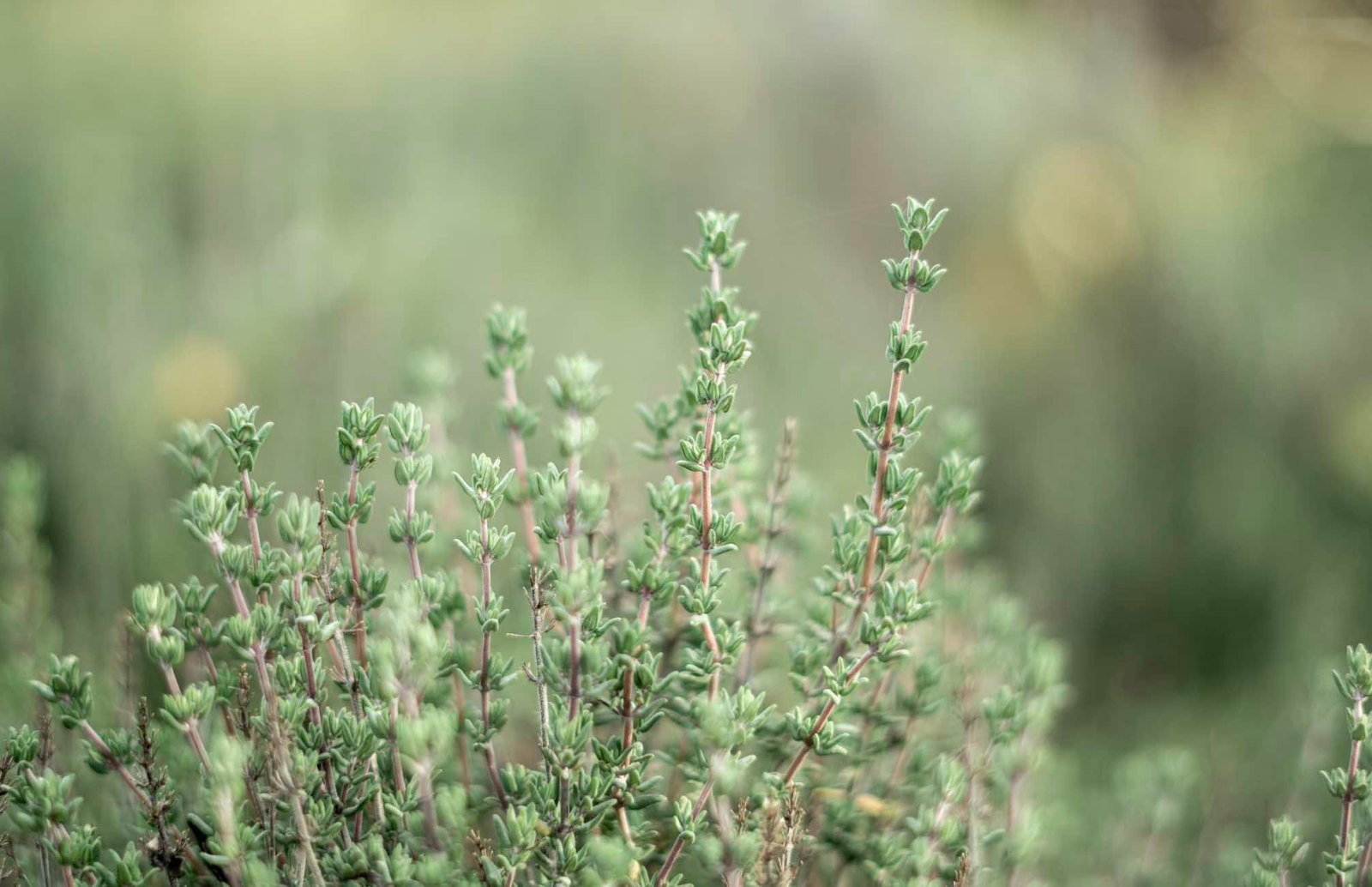
With proper care and good ventilation, thyme in a greenhouse rarely gets sick.
Possible problems:
- Root and stem rot: They develop with excessive watering, poor drainage and insufficient ventilation.
- Control measures: Immediately improve drainage and reduce watering. Remove affected parts of the plant. Treat with a fungicide (such as Fitosporin-M).
- Powdery mildew: Whitish coating on leaves.
- Control measures: Improve ventilation. Treat with a fungicide.
- Aphids, spider mites: They may appear, especially if there are other affected crops nearby.
- Control measures: Spray with a soap solution or insecticidal herbal infusions. In case of severe infestation, use appropriate insecticides or acaricides.
Preventive measures:
- Strict adherence to the watering regime (avoid over-watering).
- Ensuring excellent drainage.
- Regular ventilation of the greenhouse.
- Use of healthy planting material.
- Timely weeding and removal of plant debris.
Harvesting and storage
- When to collect: Thyme sprigs can be cut as needed throughout the growing season. The strongest aroma and highest essential oil content occur during the early flowering period.
- How to assemble: Trim the tops of the shoots (5-10 cm) with a sharp knife or scissors. Don't cut more than 2/3 of the shoot's length and don't completely expose the bush to allow it to recover.
- Drying:
- Tie the cut branches into small, loose bundles and hang them in a dry, dark, well-ventilated area.
- You can spread the greens in a thin layer on paper or mesh.
- Dried thyme (leaves and small sprigs) is stored in tightly sealed glass or ceramic jars in a dark place.
- Freezing: Fresh sprigs can be finely chopped and frozen in ice cube trays with a little water or olive oil.
- Use fresh: Fresh thyme will keep in the refrigerator's vegetable drawer for several days (wrapped in a damp paper towel).
Thyme: The aromatic heart of your greenhouse
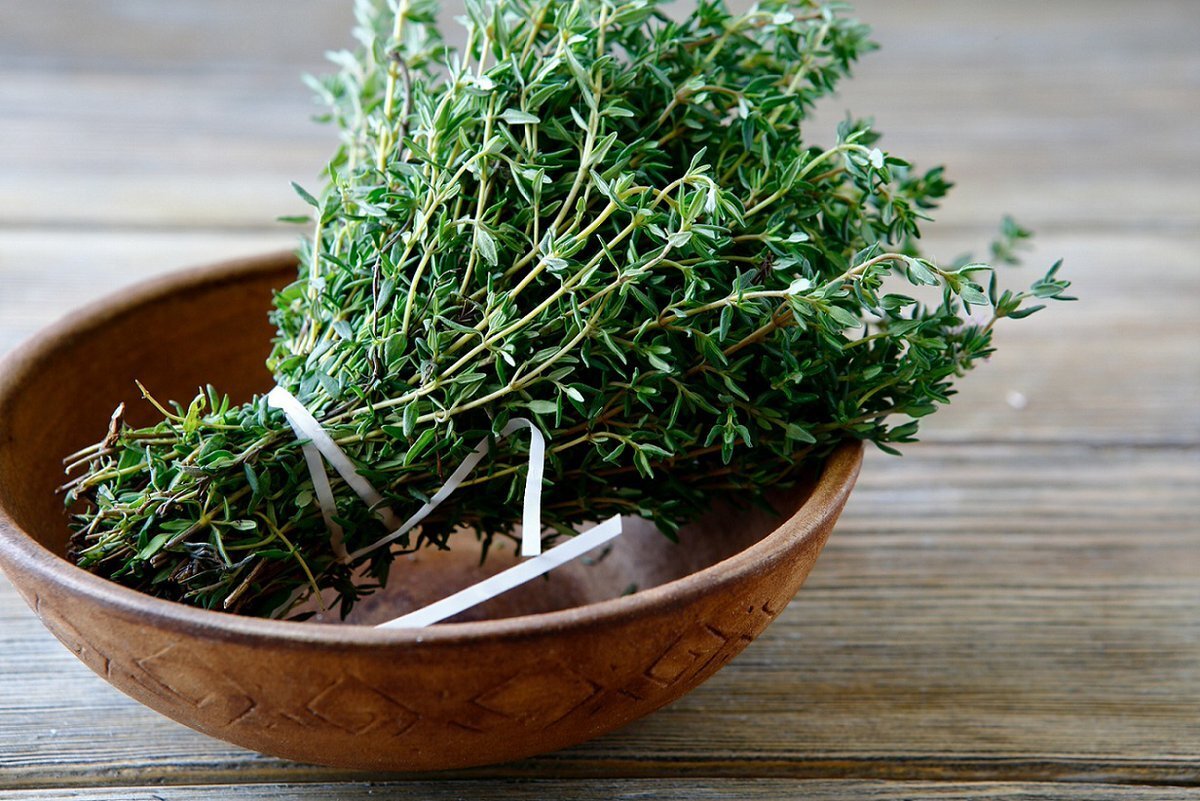
Thyme, grown in a greenhouse with love and expertise, can transform an ordinary space into a true oasis of Mediterranean aroma and comfort. Together, we've explored everything from choosing the right variety, capable of revealing its full beauty in greenhouse conditions, to the secrets of preparing the ideal soil and creating a microclimate in which this modest yet valuable shrub will feel at home. You've learned about various planting methods—from patiently growing from seed to quickly rooting cuttings—as well as the intricacies of care, where moderate watering, plenty of sun, and good ventilation are key.
Proper pruning will not only ensure a regular harvest of fragrant sprigs but also help you form beautiful, lush bushes. Knowing how to prevent diseases and harvest on time will allow you to enjoy thyme's bounty for as long as possible. A greenhouse is your tool for managing nature, allowing you to overcome climate limitations and get the best from this amazing plant.
Let your greenhouse thyme become more than just a kitchen herb, but a symbol of your ability to create beauty and benefit with your own hands, filling every day with subtle notes of summer warmth and health. Care for it with love, and it will surely reward you with a bountiful harvest and a unique fragrance.





